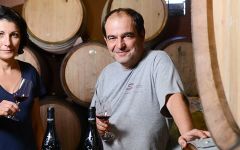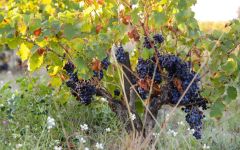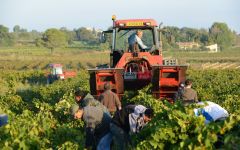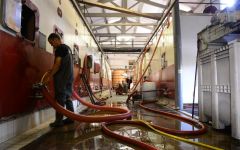Domaine de la Janasse Chateauneuf-du-Pape Blanc 2023
-
Jeb
Dunnuck -
Wine
Spectator -
James
Suckling - Vinous



Product Details
Your Rating
Somm Note
Winemaker Notes
The Châteauneuf-du-Pape Blanc from Domaine de la Janasse is sourced from sandy soils in the lieux-dits of La Janasse and Le Crau where the Sabon family tend about 1.5 ha of white varieties, mainly Grenache Blanc with smaller plantings of Clairette and Roussanne. The Grenache and Clairette are fermented and aged in vats and foudre while the Roussanne is fermented and age in French oak barrels.
Professional Ratings
-
Jeb Dunnuck
A blend of 40% Grenache Blanc and the rest mostly Clairette and Roussanne, the 2023 Châteauneuf Du Pape Blanc shows the fleshy, upfront, ripe, supple style of the vintage. Ripe peach, orange blossom, toasted spice, and honeyed flower notes all define the aromatics, and it's medium to full-bodied, with a concentrated, opulent mouthfeel and a great finish.
-
Wine Spectator
Voluptuous yet fresh, with a flattering kiss of oak polish overhanging pear, melon and star fruit. Spicy and luscious on the fleshy palate. Flinty minerals bring good firmness and the succulent finish resonates with salt and smoke.
-
James Suckling
A delicious, round and balanced white with notes of green pears, anise and warm herbs. Medium-bodied with a succulent development on the palate. There is a positive bitterness here with a delicate texture and a exciting kick of herbs in the finish. Good persistence.
-
Vinous
The 2023 Châteauneuf-du-Pape Blanc unwinds with white peach, ripe pear, yellow apple and cedar aromas of good intensity. Concentrated and rich, the full-bodied 2023 concludes with solid drive on the generous finish.
Other Vintages
2022-
Jeb
Dunnuck -
Wine
Spectator -
Robert
Parker
- Vinous
-
Jeb
Dunnuck -
James
Suckling
-
Jeb
Dunnuck -
James
Suckling
-
Jeb
Dunnuck - Decanter
-
Robert
Parker
-
Wine
Spectator -
Robert
Parker -
Jeb
Dunnuck -
James
Suckling
-
Robert
Parker
-
Wine
Spectator -
Robert
Parker
-
Robert
Parker -
Wine
Spectator
-
Robert
Parker






Domaine de la Janasse has quickly become one of the Superstar estates of Chateauneuf-du-Pape. Led by the dynamic Christophe Sabon, the estate combines the best of both traditional and modern techniques to craft a collection of truly riveting wines from “simple” value-priced VDP’s to benchmark Chateauneufs.
The estate was founded in 1976 by Aimé Sabon, Christophe’s father, who still oversees the vineyards and farms organically. The property consists of 40 Hectares, spread over as many as 70 different parcels throughout the appellation.
While Aime works in the vineyards, his son, Christophe Sabon, is in charge of wine production. Christophe is a self-proclaimed “great defender of Grenache,” which still represents 75% of their vines. He manages the common rusticity of Grenache-based wines through meticulous work in the vineyards and cellar. The result is a wide range of lavishly ripe, extracted Chateauneuf-du-Papes and Cotes-du-Rhônes that are complex and yet balanced with acidity -- often in contradiction to an appellation better known for sheer exuberance and power. As Robert Parker points out: “The young and talented Christophe Sabon continues to display the sure-handed touch of a veteran winemaker”.

Full-bodied and flavorful, white Rhône blends originate from France’s Rhône Valley. Today these blends are also becoming popular in other regions. Typically some combination of Grenache Blanc, Marsanne, Roussanne and Viognier form the basis of a white Rhône blend with varying degrees of flexibility depending on the exact appellation. Somm Secret—In the Northern Rhône, blends of Marsanne and Roussanne are common but the south retains more variety. Marsanne, Roussanne as well as Bourboulenc, Clairette, Picpoul and Ugni Blanc are typical.

Famous for its full-bodied, seductive and spicy reds with flavor and aroma characteristics reminiscent of black cherry, baked raspberry, garrigue, olive tapenade, lavender and baking spice, Châteauneuf-du-Pape is the leading sub-appellation of the southern Rhône River Valley. Large pebbles resembling river rocks, called "galets" in French, dominate most of the terrain. The stones hold heat and reflect it back up to the low-lying gobelet-trained vines. Though the galets are typical, they are not prominent in every vineyard. Chateau Rayas is the most obvious deviation with very sandy soil.
According to law, eighteen grape varieties are allowed in Châteauneuf-du-Pape and most wines are blends of some mix of these. For reds, Grenache is the star player with Mourvedre and Syrah coming typically second. Others used include Cinsault, Counoise and occasionally Muscardin, Vaccarèse, Picquepoul Noir and Terret Noir.
Only about 6-7% of wine from Châteauneuf-du-Pape is white wine. Blends and single-varietal bottlings are typically based on the soft and floral Grenache Blanc but Clairette, Bourboulenc and Roussanne are grown with some significance.
The wine of Chateauneuf-du-Pape takes its name from the relocation of the papal court to Avignon. The lore says that after moving in 1309, Pope Clément V (after whom Chateau Pape-Clément in Pessac-Léognan is named) ordered that vines were planted. But it was actually his successor, John XXII, who established the vineyards. The name however, Chateauneuf-du-Pape, translated as "the pope's new castle," didn’t really stick until the 19th century.
